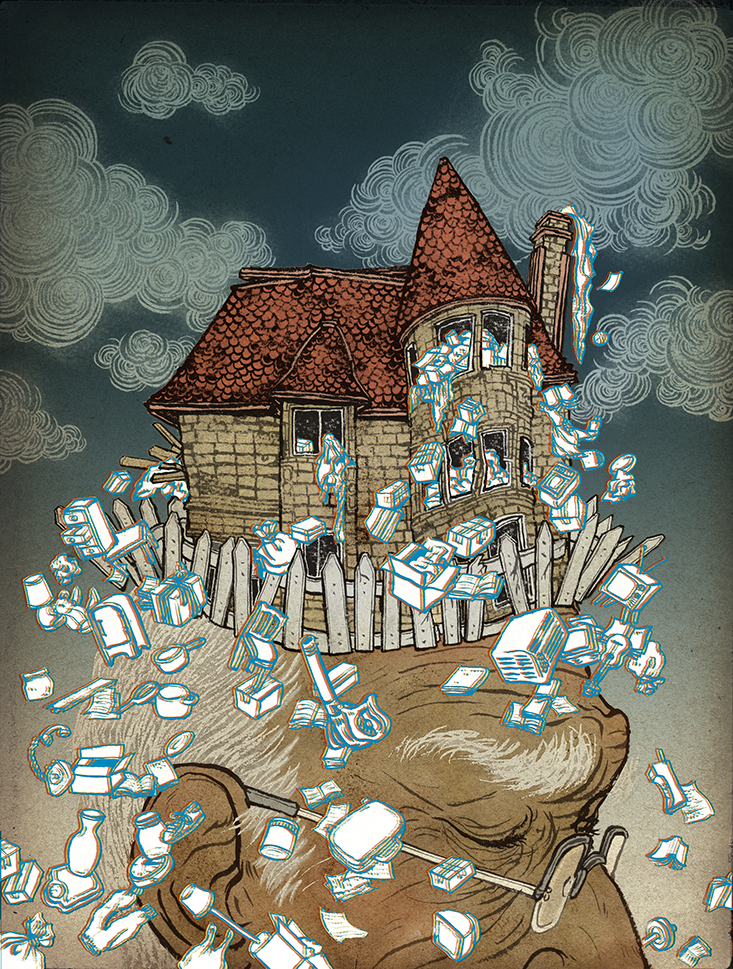Animals like to hoard. Christopher E. Overtree, director of the Psychological Services Center at the University of Massachusetts, Amherst and a specialist in treating hoarding, says that “the mechanisms triggering this kind of biological reflex are present in all of us.” A friend of his in Minnesota had an eagle’s nest on his property fall from a tree. This led to a surprising discovery: 23 dog and cat collars. “The eagle ate the animals but saved the collars,” says Overtree. His own cat, Gus, wasn’t much better. Overtree recently tailed his cat sneaking off with his wife’s costume jewelry, dragging the trinkets into the attic and stashing them in a hole in the floor. “I realized he must be saving it,” says Overtree. “I think it is interesting to see a behavior that has no practical value in an animal.”
Hoarding, some scientists suggest, is a sensible action to take in an uncertain world. “We have been shaped by evolutionary pressures in the past to deal with resource scarcity, and hoarding is one of those possible strategies,” says John L. Koprowski, professor of wildlife conservation and management at the University of Arizona and an authority on squirrels. He refutes the conventional wisdom that squirrels only gather what they need to survive winters. Studies of eastern gray squirrels, for instance, suggest that up to 74 percent of buried acorns are never recovered. They could be lost—or simply stored, just in case.
The eagle ate the animals but saved the collars.
While saving up in this manner seems both sensible and prevalent among animals, it is a bona fide disease among humans. This year, for the first time, the fifth edition of the Diagnostic and Statistical Manual of Mental Disorders, or DSM—the bible of psychiatrists and insurers—listed it as a distinct disorder. It is also one with serious consequences, with the potential to ruin relationships, result in evictions, and fuel lethal fires. And according to the American Psychiatric Association, 2 to 5 percent of the United States population suffers from it.
After all, we are being pushed to consume. “Contemporary U.S. households have more possessions per household than any society in global history,” explains Jeanne E. Arnold, professor of anthropology at the University of California, Los Angeles (UCLA). In 2012, Arnold and a team of sociologists and anthropologists published a book, Life at Home in the Twenty-First Century, based on a four-year study of 32 middle class, dual-income families in Los Angeles. The authors found that 75 percent of families banished their cars from garages “to make way for rejected furniture and cascading bins and boxes of mostly forgotten household goods.” Superstores like Costco, they argued, have increased our tendency to stockpile food and cleaning supplies—and the result at home is stress. Women who described their homes as cluttered had higher cortisol levels—a sign of stress—than those who didn’t.
The line between hoarding, the mental disorder, and hoarding, the bad habit (or natural tendency), is worth considering. Does saving your children’s finger paintings from 1982 mean you have a de-acquisitioning problem? What about those boxes of clothes sized 30 pounds ago in your closet instead of at Goodwill? The popularity of hit reality shows like Hoarders and Hoarding: Buried Alive is surely due in part to the fact that we see ourselves in even the most extreme cases. The boundaries of this debate reveal something about who we are as people.

On a tidy street in a resurgent New England mill town, where the trimmed bushes look like green thimbles mounted in mulch, Melvin’s large Victorian house sticks out. Two bicycles, one missing the front wheel, lean against threadbare front steps; stacks of two-by-fours, rakes, and bicycle tires piled up on a desk surround the front door. Melvin, an erudite lawyer in his late 60s who requested a pseudonym, wears khakis and a pressed blue-and-white shirt with neatly rolled up cuffs, looking a bit like the late Canadian actor Conrad Bain. He speaks fluent French and can get by in Russian. He nimbly chats about Robert Pinsky one minute and Oriana Fallaci the next. The divorced father of two is quick with a joke or a boast about his children. He loves to bake, particularly Linzer tortes.
Melvin hasn’t invited anyone into his home in more than a year; he reveals this while leading me, single file, through piles of possessions on narrow paths, known in hoarder parlance as “goat trails.” Cans, dishes, and mugs blanket kitchen countertops. He hands me a laser pointer so I can ask about his many inaccessible items as we stroll through the house. We encounter roughly 200 musical instruments in various states of repair, scores of VHS tapes, racks of dress shirts, vintage radios, several skis, a dozen or so motorcycle helmets, and countless books—some in barrister bookcases, others in boxes. He owns a valuable watercolor by Whistler as well as a worthless stuffed blue parrot that looks like a carnival prize.
Melvin says he can remember a time before the clutter crept up on him and the house was “light and airy.” He bought his place about 20 years ago after a bitter divorce and soon found a housemate he enjoyed socializing with. He hosted home-cooked dinners and raucous dance parties, but after his housemate moved out, stuff moved in. “Slowly it got filled up floor to ceiling,” he says. Melvin, however, insists that he is not a hoarder. “I don’t think of it as hoarding at all,” he says. “That implies greed, one of the medieval sins. It’s really an accumulation of stuff, and it happens because I have an eye for everything under history.” But, I ask, wouldn’t he admit his collecting has gotten out of hand? He thinks about it and responds, gently, “I have a problem de-acquisitioning things.”
Melvin hasn’t invited anyone into his home in more than a year; he reveals this while leading me, single file, through piles of possessions on narrow paths.
Is Melvin’s self-diagnosis right? Is he really a quirky, but normal, collecting enthusiast with a particularly strong attachment to what he judges as treasures? Probably not. In fact, it is this very human feeling of attachment which is the first step in a hoarding disorder. Randy O. Frost, a professor of psychology at Smith College, and coauthor of Stuff: Compulsive Hoarding and the Meaning of Things, saw this extreme attachment form in real time, in a set of psychology experiments involving a rather unexciting collectible: Key chains. He distributed key chains to both hoarders and non-hoarders, asking each group to rate their attachment to the trinket during the course of a week. He expected the connection to grow gradually. “That didn’t happen,” he recounts. “[Hoarders] had it immediately. It told me something about the way in which attachment occurs, that it happens immediately on ownership.”
Attachment becomes strengthened by forgetting that the object is just an object. Carolyn Rodriguez, who directs the Hoarding Disorder Research Program at Columbia University, says some of her clients assign human qualities to objects. “For many patients, the main relationship in their lives is not with another person,” she observes. “Instead, it’s a relationship they have with their stuff—and their stuff is what they turn to for companionship and comfort.” The objects can serve as a stand-in for a person. “People will pull a calendar from 2002 out of a box and cry at how deeply that calendar connects them to the things they did in 2002, or the people they loved in 2002,” says Overtree, the Amherst psychologist. Discarding something stops being a simple or rational act.
Those with hoarding disorders, then, have an amplified sense of something that all of us cherish: Our deepest feelings for our families and close friends, and our artistic sensibilities. On the second floor of Melvin’s house, he has half-a-dozen pairs of cowboy boots in boxes, but he owns many more. “This isn’t my Western boot room,” he jokes. He has a thing for the Luccese brand—“the best American cowboy boots” in his opinion—so he buys them at yard sales, flea markets, and thrift shops. “I’ll pick them up for any friends I have that might be that size,” he says. Melvin’s daughter says that her father is one of the most generous people she knows, but he obviously amasses more gifts than he has potential recipients.
While Melvin’s house is overstuffed, many of his books, vintage radios, and musical instruments mean the world to him. “I appreciate the craftsmanship and the beauty that goes into them,” he says. “Everybody else has an iPhone and walks around being governed by an iPhone. For me it’s objects, and I love them.”
Overtree says people who can’t part with their possessions often see an inherent beauty in them. And that’s a quality he doesn’t want to tarnish. “I have been trying to figure out where is the sweet spot between curing somebody and helping them live a happy and productive life,” he says. Beauty is a dangerous thing, another psychologist told me. How do we hold onto the things that we love and cherish without being overwhelmed by them? How do we learn to let go?
There is, however, a second component to hoarding disorders that has less to do with an amplification of what makes us human, and more to do with a diminishment. Psychiatrist Sanjaya Saxena of the University of California, San Diego, found that patients with compulsive hoarding syndrome showed “diminished activity in several parts of the cingulate cortex,” the part of the brain that governs motivation, executive control, and response to conflict. Phil Wolfson, a psychiatrist based in San Francisco, told me patients with hoarding problems “are often depressed, they are often isolated socially or socially phobic, or they are obsessive-compulsive people; they have all kinds of other habits, difficulties, and anxieties.”
“I don’t think of it as hoarding at all. That implies greed, one of the medieval sins. It’s really an accumulation of stuff.”
But some of the same brain areas that are underactive under normal circumstances become hyperactive when hoarders are confronted with their possessions. David F. Tolin of the Yale University School of Medicine asked participants in a study to decide whether their old papers can be shredded, while monitoring their brain activity. He found that hoarders’ brains zoomed into overdrive like a seismograph measuring an earthquake—compared to healthy controls. (That didn’t happen when they watched someone else’s papers being ditched.) “The parts of the brain involved in helping you gauge that something is important are kicked into such overdrive that they are maxed out, so everything seems important,” Tolin explains.
Monika Eckfield, a professor of physiological nursing at California State University, San Francisco, concurs that many hoarding patients struggle with processing information. To avoid the anxiety of throwing something away, they simply put off the decision to do so. “This is common to all of us,” Eckfield says. Like the neuroscientists, she believes hoarding becomes abnormal as a result of “mis-wiring” in the brain’s executive functions. Chronic hoarders “have a much harder time following through,” she says. “They get distracted. They get disorganized. They end up adding to the pile, and the idea of sorting through those piles is very overwhelming.”
Modern science has clearly revealed why hoarding deserves the designation of “disorder”: It is reflected in physical differences in how the brain is wired. At the same time, it is something that reflects to us some of the qualities and decisions with which we all struggle: Consumerism, attachment, decision-making, time management—and, at some level, survival. I’m left wondering if it is any coincidence that it was in 2013, when society demands so much from us in each of these capacities, that hoarding has taken on full-fledged disorder status in the DSM-V handbook.
David Wallis has contributed to The New Yorker, Wired, Esquire, The New York Times, and other publications. He is also the editor of Killed: Great Journalism Too Hot To Print, and Killed Cartoons: Casualties from the War on Free Expression.


























